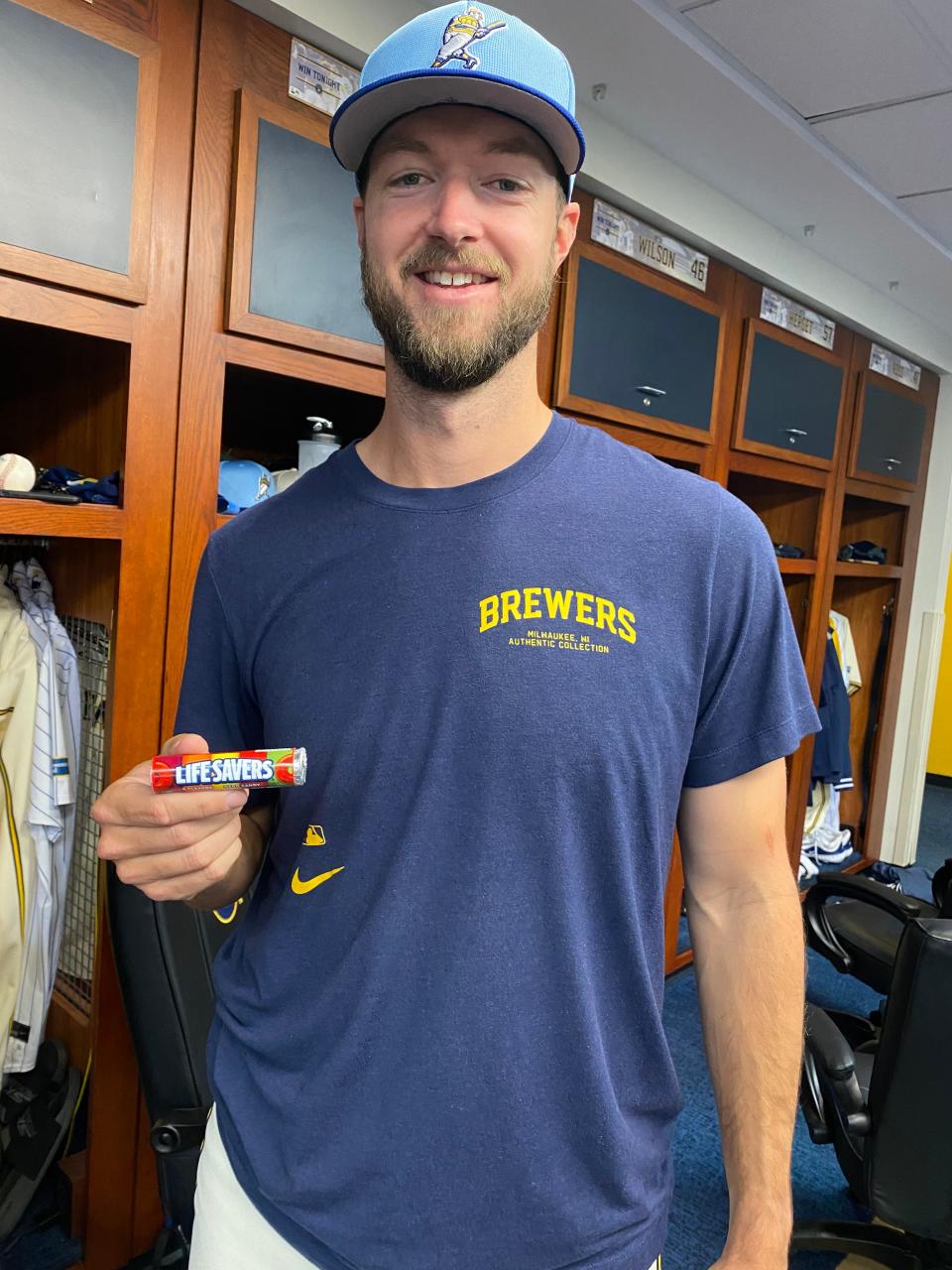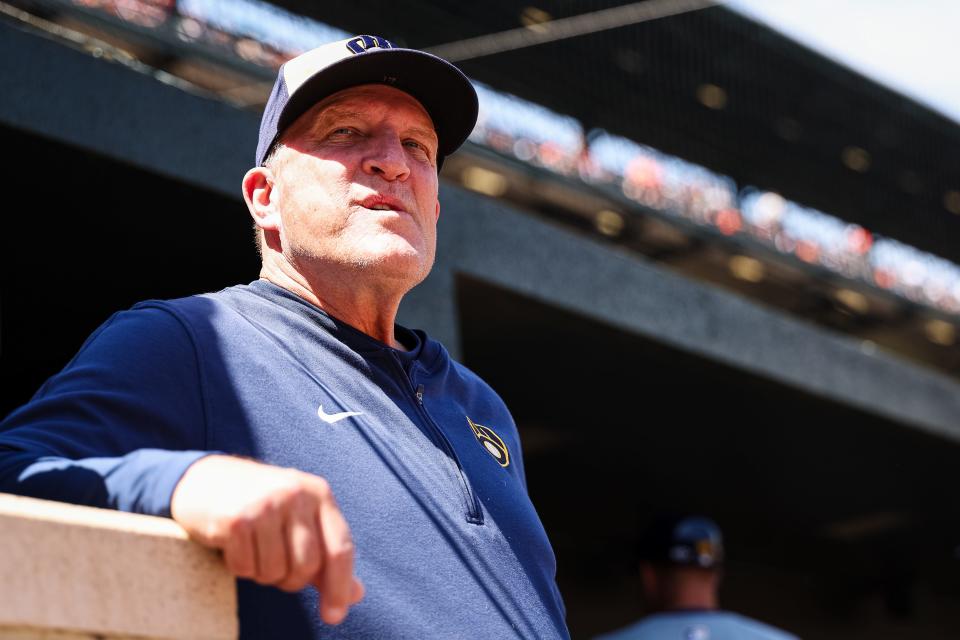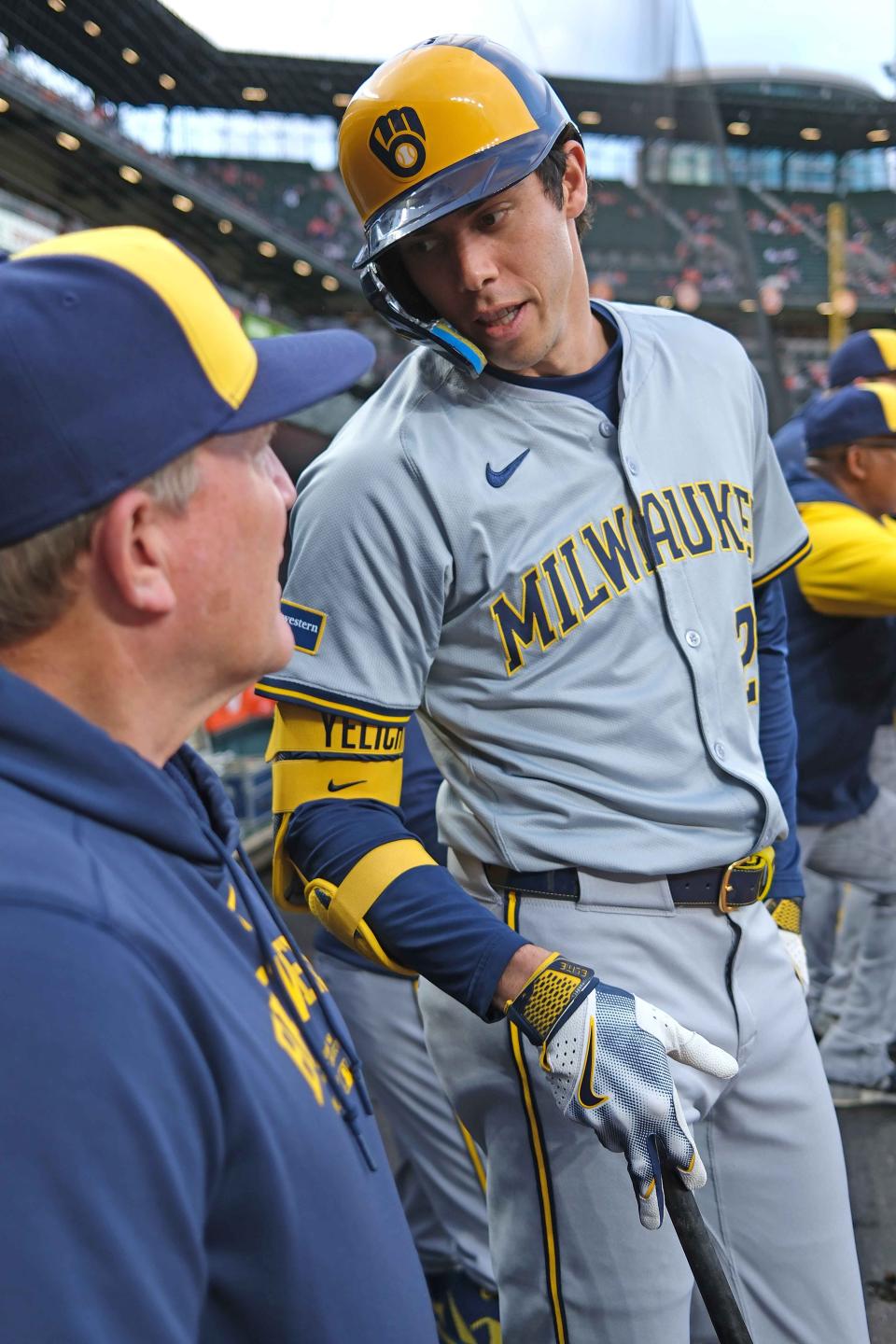The 'orange Life Savers' of MLB: How a Pat Murphy theory on candy is central to the Brewers' winning ways
Inside the dining room of the home clubhouse at American Family Field is a new snack item, added recently to the litany of options for players to crunch and munch before or after a game: Life Savers.
Most players bypass the colorful confectionery for a different option, potentially either a sign of where the hard, round, fruity treat has fallen in the stratosphere of preferred sweets or simply a byproduct of baseball players being creatures of habit.
“Probably third grade,” starting pitcher Colin Rea says was the last time he ate Life Savers. “I grab them for my kids.”
The candy flies a bit under the radar in the Milwaukee Brewers cafeteria, but perhaps that’s fitting.
So do the players who bypass it, even if they themselves are, as manager Pat Murphy would say, orange Life Savers.

How Pat Murphy's theory on a sweet candy applies to baseball
Murphy has a long held theory about baseball players.
As head coach at Arizona State, where he won 629 games and four times made the College World Series, he recruited a bit differently, choosing to go after the overlooked players whose talent was modest but work ethic was indefatigable instead of the stars.
He once got fed up with his staff for only bringing elite athletes to the table in recruiting meetings and brusquely opined, “Can we find some red-headed, short-armed lefty?”
The next day, a photo of a red-headed, short-armed lefty at a junior college two hours north was on his desk. His name was Kole Calhoun. He ultimately helped lead the Sun Devils to the College World Series and played 12 years in the major leagues.
That was the mold of player, under-recruited and undervalued, who often thrived under Murphy. Dustin Pedroia, Willie Bloomquist, Jason Kipnis and Andre Ethier were that way, too.
And Murphy had a name for those types of players.
Orange Life Savers.
“What’s the first thing you do when you get a pack of Life Savers?” Murphy explained. “You open it up and you take the red ones. Everyone likes the red ones. Nobody wants the orange. I always had a theory that I liked the orange Life Savers.
“When you recruit the red Life Savers, they end up disappointing you a lot of times. The orange Life Savers for me were the ones that were valuable because everyone is going after the red. I want the orange, which is for me the second-best Life Saver.”
It's through this lens that Murphy views much of the game of baseball.
“He wants the guys that have to grind, that are going to work hard, that are going to listen,” Bloomquist said. “The B+ talent guys, in his words. He demands the best out of guys. He puts guys in challenging situations and demands they hold themselves to a higher standard.”
The orange Life Savers of the Brewers
Before a recent game, Murphy was asked to run down a list of who the Brewers' orange Life Savers are.
“Let’s see. I gotta remember the names of the guys," he responded in his typical jestful fashion.
“(Sal) Frelick, orange Life Saver. Tyler Black – is that his first name, Tyler? Orange Life Saver. (Brice) Turang, (Rhys) Hoskins, orange Life Saver.
"(Oliver) Dunn? Green Life Saver. (Blake) Perkins, green Life Saver."
Wait, green Life Saver?
“Green’s like a survivor," Murphy explains. "You’re the only one left."
This is the type of team, abundant in orange (and apparently green) Life Savers, that Murphy has in his first season as full-time manager in the big leagues.
They were young to begin with. Then they dealt with a rash of injuries to top contributors.
The Brewers have used 10 starting pitchers without any “openers,” which is two more than the next-closest team. They have the youngest average position player age in the National League. Six of their nine most-used batters came into the season with less than one year of major-league service time.
“I’d be an orange Life Saver,” reliever Hoby Milner said. “(Joel) Payamps and (Elvis) Peguero are orange Life Savers. (Bryan) Hudson. Thyago (Vieira). (Trevor) Megill. Pretty much our whole bullpen is orange Life Savers.”
Said Rea: "I’m definitely an orange Life Saver."

Buy-in from Brewers roster is leading to results
Yet this is precisely how Murphy prefers it to be – a ragtag group reminiscent to some of his best ASU teams.
Of course, the Brewers winning on the margins of the roster is nothing new. It’s something they have done in years past under Craig Counsell before he bolted 90 miles south to manage the Cubs, but even then those teams featured elite pitching with name-brand arms such as Corbin Burnes, Brandon Woodruff and Josh Hader.
The 2024 Brewers are a different bunch. They're constructed more eclectically.
So, while you can still see Murphy getting acclimated to some of the in-game tactics the job requires, his style, akin in many ways to what you see at the college level, fits a young team perfectly.
“It does feel a little more college-type atmosphere,” Milner said. “A little more gritty, we’re in it to win it today, everybody do whatever it takes to win today. Even the big guys in big situations don’t try to do too much. Just get it to the next guy. It’s kind of a college feel in that way because, now, across the game, it’s like everybody go up there and try to hit a homer.”
Murphy isn’t only giving this message but hammering it. He's willing to walk to the outfield and interrupt a pitcher about to make his MLB debut while warming up to remind him to pitch for the team and not himself.
Can that message be tough to get across at the major-league level in this day and age?
“I think it can go that way, for sure. That’s the battle we all have, isn’t it?” Murphy said. “We have this young group, this super young team, so why not try to extend that, is kind of my thinking. It can be cool to be a great teammate. To understand what that means to be a good teammate at that age and keep the focus like that? I think it’s really what could make us special.”
A team-first approach in pro sports, Christian Yelich believes, is preached far more than it's practiced.

"That sounds pretty easy to say, all the clichés that you hear in sports about playing for the team and we’ve got the right kind of guys," Yelich said. "But really, that doesn't happen that much. There’s not the right kind of guy a lot of times. That’s because that kind of comes with pro sports sometimes. We’ve done a really good job of having the right kind of guy, but also being talented."
The message seems to be resonating, and buy-in starts with the veterans.
"We all need to be held to the same standard, whether you’re in my position or you’re a guy who’s been here three days," Yelich said. "It’s about a team identity. If your leaders on the team go about it a certain way, then it doesn’t really give anybody an excuse to do it any other way. But that’s hard because you have to live by that every day. You can’t just say it. It’s on you to be accountable."
The Brewers' veterans, including Yelich, Hoskins, Willy Adames and Wade Miley, hold an open-forum state of the team meeting at the start of every month in which anything and everything is on the table.
“We’ve had examples of guys in the past who are at the all-star break with like 10 home runs and they’re not big homer guys,” Milner said. “But they’re like, ‘If I just get 20 then I’ll be sitting pretty for next year.’
“That doesn’t help us out. Literally doesn’t help us. I like that everyone is bought in. We’ll all do whatever it takes.”
The Brewers' approach is translating from the manager's office onto the field, where this ensemble of off-colored Life Savers are in first place, while once again leaving national pundits wondering just how the heck they’re doing it.
“Collectively,” said outfielder Blake Perkins, a green Life Saver. “We all kind of have our own mesh.”
The rest of Perkins’ answer was drowned out by a chorus of nearly a dozen fully uniformed rookies who had just returned from a Starbucks run to the clubhouse with coffee orders for the entire team.
Collectively, indeed.
This article originally appeared on Milwaukee Journal Sentinel: The Brewers are the orange Life Savers of MLB. Here's what that means.

